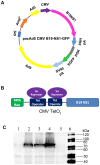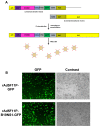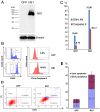Establishment of a Parvovirus B19 NS1-Expressing Recombinant Adenoviral Vector for Killing Megakaryocytic Leukemia Cells
- PMID: 31487941
- PMCID: PMC6783920
- DOI: 10.3390/v11090820
Establishment of a Parvovirus B19 NS1-Expressing Recombinant Adenoviral Vector for Killing Megakaryocytic Leukemia Cells
Abstract
Adenoviral viral vectors have been widely used for gene-based therapeutics, but commonly used serotype 5 shows poor transduction efficiency into hematopoietic cells. In this study, we aimed to generate a recombinant adenovirus serotype 5 (rAd5) vector that has a high efficiency in gene transfer to megakaryocytic leukemic cells with anticancer potential. We first modified the rAd5 backbone vector with a chimeric fiber gene of Ad5 and Ad11p (rAd5F11p) to increase the gene delivery efficiency. Then, the nonstructural protein NS1 of human parvovirus B19 (B19V), which induces cell cycle arrest at the G2/M phase and apoptosis, was cloned into the adenoviral shuttle vector. As the expression of parvoviral NS1 protein inhibited Ad replication and production, we engineered the cytomegalovirus (CMV) promoter, which governs NS1 expression, with two tetracycline operator elements (TetO2). Transfection of the rAd5F11p proviral vectors in Tet repressor-expressing T-REx-293 cells produced rAd in a large quantity. We further evaluated this chimeric rAd5F11p vector in gene delivery in human leukemic cells, UT7/Epo-S1. Strikingly, the novel rAd5F11p-B19NS1-GFP vector, exhibited a transduction efficiency much higher than the original vector, rAd5-B19NS1-GFP, in UT7/Epo-S1 cells, in particular, when they were transduced at a relatively low multiplicity of infection (100 viral genome copies/cell). After the transduction of rAd5F11p-B19NS1-GFP, over 90% of the UT7/Epo-S1 cells were arrested at the G2/M phase, and approximately 40%-50% of the cells were undergoing apoptosis, suggesting the novel rAd5F11P-B19NS1-GFP vector holds a promise in therapeutic potentials of megakaryocytic leukemia.
Keywords: adenoviral vector; anti-cancer; apoptosis; cell cycle arrest; parvovirus B19.
Conflict of interest statement
The authors declare no competing financial interests.
Figures





Similar articles
-
Human parvovirus B19 DNA replication induces a DNA damage response that is dispensable for cell cycle arrest at phase G2/M.J Virol. 2012 Oct;86(19):10748-58. doi: 10.1128/JVI.01007-12. Epub 2012 Jul 25. J Virol. 2012. PMID: 22837195 Free PMC article.
-
Human parvovirus B19 nonstructural protein (NS1) induces cell cycle arrest at G(1) phase.J Virol. 2003 Mar;77(5):2915-21. doi: 10.1128/jvi.77.5.2915-2921.2003. J Virol. 2003. PMID: 12584315 Free PMC article.
-
Parvovirus B19 NS1 protein induces cell cycle arrest at G2-phase by activating the ATR-CDC25C-CDK1 pathway.PLoS Pathog. 2017 Mar 6;13(3):e1006266. doi: 10.1371/journal.ppat.1006266. eCollection 2017 Mar. PLoS Pathog. 2017. PMID: 28264028 Free PMC article.
-
Recombinant human parvovirus B19 vectors.Pathol Biol (Paris). 2002 Jun;50(5):295-306. doi: 10.1016/s0369-8114(02)00310-3. Pathol Biol (Paris). 2002. PMID: 12116848 Review.
-
Unscrambling the role of human parvovirus B19 signaling in systemic autoimmunity.Biochem Pharmacol. 2006 Nov 30;72(11):1453-9. doi: 10.1016/j.bcp.2006.04.023. Epub 2006 May 4. Biochem Pharmacol. 2006. PMID: 16764828 Review.
Cited by
-
Chaperonin TRiC/CCT subunit CCT7 is involved in the replication of canine parvovirus in F81 cells.Front Microbiol. 2024 Feb 7;15:1346894. doi: 10.3389/fmicb.2024.1346894. eCollection 2024. Front Microbiol. 2024. PMID: 38384266 Free PMC article.
-
New Insights into Parvovirus Research.Viruses. 2019 Nov 13;11(11):1053. doi: 10.3390/v11111053. Viruses. 2019. PMID: 31766142 Free PMC article.
-
For better or worse: crosstalk of parvovirus and host DNA damage response.Front Immunol. 2024 Feb 23;15:1324531. doi: 10.3389/fimmu.2024.1324531. eCollection 2024. Front Immunol. 2024. PMID: 38464523 Free PMC article. Review.
-
Emulating interactions between microorganisms and tumor microenvironment to develop cancer theranostics.Theranostics. 2022 Mar 14;12(6):2833-2859. doi: 10.7150/thno.70719. eCollection 2022. Theranostics. 2022. PMID: 35401838 Free PMC article. Review.
References
-
- Nilsson M., Ljungberg J., Richter J., Kiefer T., Magnusson M., Lieber A., Widegren B., Karlsson S., Fan X. Development of an adenoviral vector system with adenovirus serotype 35 tropism; efficient transient gene transfer into primary malignant hematopoietic cells. J. Gene Med. 2004;6:631–641. doi: 10.1002/jgm.543. - DOI - PubMed
Publication types
MeSH terms
Substances
LinkOut - more resources
Full Text Sources
Research Materials

